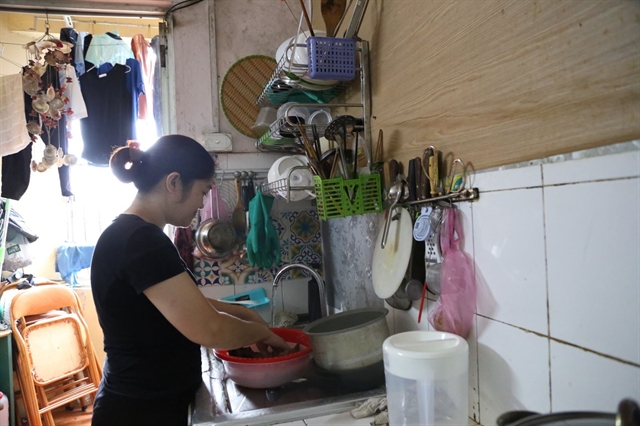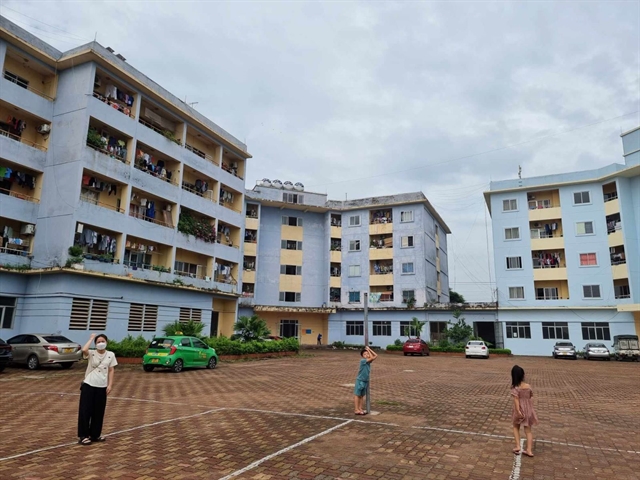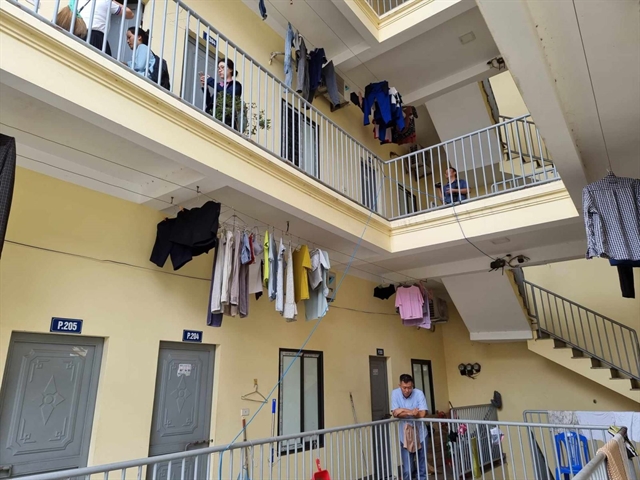 Society
Society


|
| Đặng Thị Thu Huệ, from Thái Bình Province, at an apartment in the pilot social housing project for workers in Đông Anh District. — VNA/VNS Photos |
HÀ NỘI — Hà Nội has been piloting the construction of large-scale social housing for workers in the Bắc Thăng Long Industrial Zone for several years.
However, the worker housing supply still fails to meet demand.
Bắc Thăng Long Industrial Zone in Đông Anh District has over 80 per cent of migrant workers, resulting in a high demand for rental homes.
Many workers have been working here for more than 10 years, but owning an apartment in the social housing project remains a difficult and distant prospect for the majority of labourers, according to the Tin Tức (News) online newspaper.
Cù Thị Thới, a worker from Sơn La Province, has been renting a room in Bầu Village, Kim Chung Commune, Hà Nội's Đông Anh District, for over 10 years.
"I have changed accommodation many times since working in Bắc Thăng Long Industrial Zone. When I was younger, my friend and I used to rent a 10sq.m room. Later, after getting married and having children, I moved to larger rooms. Currently, I rent a 30sq.m room for over VNĐ1.8 million," Thới said.
"The total income of my husband and me is about VNĐ20 million monthly. However, with the costs of education for our children and the rising cost of living, we have almost no savings to consider buying a house. We have also decided that we will return to our hometown when we no longer work here."
Another worker, Nguyễn Văn Thuận, from Thái Nguyên Province, is currently renting a room from a local resident in the Bầu Village with an area of over 20sq.m at a price of VNĐ1.6 million.
"The apartment is newly built, and the furnishings are also new, so the price is slightly higher compared to some other places. The company is reducing overtime hours due to a lack of orders, which is also affecting my income. My wife and I are forced to send our child back to our hometown to reduce living expenses. With these difficulties, we dare not think about buying a house."
Not having to rent accommodation from locals, Đặng Thị Thu Huệ, 40, from Thái Bình Province, has been renting an apartment in a social housing building for workers for eight years.
"I have been a worker in the Bắc Thăng Long Industrial Zone for 17 years. In 2015, after hearing about the social housing project for workers, I completed all the procedures to be able to move into this housing complex. The apartment is about 75sq.m, with a cost of VNĐ1.6 million per month, which includes electricity and water charges," Huệ said.
However, when asked about the desire to own an apartment here, Huệ said: "Our living expenses already take up most of our monthly income of just over VNĐ10 million, making it difficult to save money to buy an apartment in the social housing projects. An 8 per cent interest rate for a loan to buy social housing is impossible for workers. Therefore, we have decided to rent a house, and when we can no longer work, we will return to our hometown."
Nguyễn Thị Thu Hường, a 23-year-old employee of Canon Vietnam, is living in a shared apartment. The 20sq.m room has three bunk beds for six people.
"The price is only VNĐ50,000 per month. If you live alone, it's quite convenient," said Hường.

|
| Social housing buildings for workers in Bắc Thăng Long Industrial Zone. |
Surveys indicate that with workers' current income, they must carefully balance their expenses to ensure they can afford rent, living costs, and childcare. Workers hope that the companies where they work will implement more support policies regarding housing rent and salaries to help them maintain their quality of life.
Infrastructure deterioration
The Bắc Thăng Long Industrial Zone, established over 26 years ago, has attracted more than 22,000 workers from various regions. This area has also been part of Hà Nội's pilot project to construct social housing for workers on a large scale.
Hà Nội initiated a pilot project in Kim Chung Commune, Đông Anh District, about 15 years ago. The project was constructed on a 20-hectare site and consists of 28 buildings with 1,532 apartments.
Currently, about 9,000 workers are living in this housing complex, and the occupancy rate is around 80 per cent.
According to workers, after 15 years of use, the infrastructure of the housing complex has deteriorated and is not regularly repaired and maintained, causing inconvenience for the tenants.
Bùi Quốc Dũng from Hà Nội Housing Management and Development Ltd Company, the housing complex management unit, admitted that the infrastructure of this housing complex does not fully meet the daily needs of workers, such as entertainment areas and social infrastructure.
"To ensure operations, the company has also established subsidiary units to oversee the housing complex. Each building has security and sanitation staff. The buildings have degraded after years of use. However, maintenance and repairs are hindered by numerous administrative processes, making it difficult to provide the best service for workers," Dũng said.
He said housing for workers should have a comprehensive design, with a clear vision for urban planning to meet the daily needs of the workers.
Head of Bầu Village, Lê Bá Hồng, said there are over 100 households with houses available for worker rentals. Of these, only 20 households have renovated their rented houses into five floors.
"With the average cost of building a 20sq.m room being over VNĐ100 million, it takes about 10 years to recover the investment. Therefore, it is very difficult for homeowners to invest in upgrading their houses."
Talking about workers' ability to own a house, Dũng said with low incomes, workers are struggling to make ends meet.
"With an 8 per cent interest rate and a loan term of only five years, workers can never consider buying a house. Therefore, once they decide to rent, they must choose a room that is suitable for their circumstances."
Seeking a proper management model
Deputy Chairwoman of the People's Committee of Đông Anh District, Nguyễn Thị Tám, said: "Housing for workers has always been a concern for local authorities. Especially after the COVID-19 pandemic, the local authorities recognised the need for more effective management solutions. We have reviewed rental housing in communes, with Kim Chung Commune alone having 800 households offering over 5,000 rooms for rent."
"Due to the limited availability of social housing for workers, many workers choose to rent rooms from local residents. Even though the living spaces may be small, they are convenient for their daily lives," Tám said.

|
| A local resident's housing for workers to rent in Kim Chung Commune. |
The local authorities have required landlords to ensure minimal infrastructure conditions for water supply and environmental quality.
"For years, Đông Anh District has also been investing in building kindergartens, primary schools, and entertainment places to provide peace of mind for workers while they are at work," the chairwoman said.
Vũ Minh Tiến, director of the Institute of Workers and Trade Unions, said in industrial and export processing zones, migrant workers make up 70-80 per cent of the workforce, but up to 90 per cent of them rent homes outside industrial zones.
"With their current low incomes, it would take 10-20 years for workers to fully repay the debt if they were to buy a home in a social housing project through instalment. Our survey shows that 90 per cent of workers have to rent social housing."
For social housing projects for workers, there needs to be a funding mechanism with reasonable interest rates so that industrial zone investors and enterprises can build social housing for workers to rent, according to Nguyễn Vân, deputy chairman of the Industry Association for Hà Nội's supporting industry.
"Based on the pilot model implemented in the Bắc Thăng Long Industrial Zone, other regions can learn from this experience and implement similar projects in other industrial zones more effectively," Vân said. — VNS




